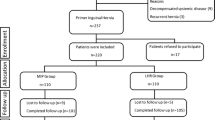Abstract
Background: There is a scarcity of data on long-term results after laparoscopic hernia repair. Herein we report on the outcome of a group of patients who were followed up for 5 years in a multicenter study on hernia repair. Methods: A total of 100 patients with 127 hernias were randomized to undergo either transabdominal preperitoneal (TAPP) or Shouldice hernia repair. Follow-up was by clinical examination and standardized questionnaire. Results: Of the 100 patients who underwent surgery, 84 were available for follow-up at 5 years. The TAPP procedure was less painful than the Shouldice repair, with fewer patients receiving narcotic analgesics. The median time to return to 100% activity was shorter in the laparoscopic group (21 days) than in the Shouldice group (40 days). Up to 60 months after the operation, the complication rate was lower in laparoscopically repaired hernias (19/66) than in the open group (25/61). There were two recurrences (3.9%) in the TAPP group and five in the Shouldice group (10.2%). Conclusion: The TAPP hernia repair yields comparable or better results than Shouldice herniorrhaphy in terms of postoperative pain, recovery, and recurrence rate.
Similar content being viewed by others
Author information
Authors and Affiliations
Rights and permissions
About this article
Cite this article
Tschudi, J., Wagner, M., Klaiber, C. et al. Randomized controlled trial of laparoscopic transabdominal preperitoneal hernioplasty vs Shouldice repair. Surg Endosc 15, 1263–1266 (2001). https://doi.org/10.1007/s00464-001-9047-0
Received:
Accepted:
Published:
Issue Date:
DOI: https://doi.org/10.1007/s00464-001-9047-0




